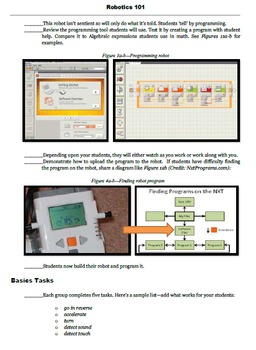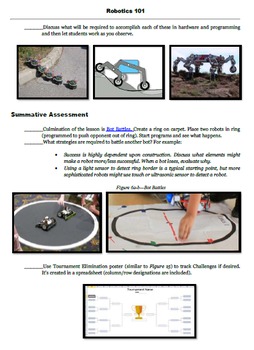Robotics 101
Ask a Tech Teacher
1.2k Followers
Grade Levels
5th - 10th
Subjects
Resource Type
Standards
CCSS6.EE.A.2
CCSSMP1
CCSSMP2
Formats Included
- PDF
Pages
13 pages
Ask a Tech Teacher
1.2k Followers
Description
This short lesson plan includes two levels of robotics: Basics and Gears. Start with the basics as an introduction and then move on to the more-complicated and more-enthusing Gears. Includes background in popular fiction, a discussion of Asimov’s Law of Robotics, how to get students started, how to make this student-directed and self-paced, and how to wrap up the year with bot battles. Students build and program their robots in groups, keep a running online journal with images and movies to share with classmates, and learn to think critically and problem-solve.
Also included are an Essential Question and Big Idea, average time required to complete, suggested appropriate grade level, suggested teacher preparation, and assessment strategies.
Total Pages
13 pages
Answer Key
N/A
Teaching Duration
N/A
Report this resource to TPT
Reported resources will be reviewed by our team. Report this resource to let us know if this resource violates TPT’s content guidelines.
Standards
to see state-specific standards (only available in the US).
CCSS6.EE.A.2
Write, read, and evaluate expressions in which letters stand for numbers.
CCSSMP1
Make sense of problems and persevere in solving them. Mathematically proficient students start by explaining to themselves the meaning of a problem and looking for entry points to its solution. They analyze givens, constraints, relationships, and goals. They make conjectures about the form and meaning of the solution and plan a solution pathway rather than simply jumping into a solution attempt. They consider analogous problems, and try special cases and simpler forms of the original problem in order to gain insight into its solution. They monitor and evaluate their progress and change course if necessary. Older students might, depending on the context of the problem, transform algebraic expressions or change the viewing window on their graphing calculator to get the information they need. Mathematically proficient students can explain correspondences between equations, verbal descriptions, tables, and graphs or draw diagrams of important features and relationships, graph data, and search for regularity or trends. Younger students might rely on using concrete objects or pictures to help conceptualize and solve a problem. Mathematically proficient students check their answers to problems using a different method, and they continually ask themselves, "Does this make sense?" They can understand the approaches of others to solving complex problems and identify correspondences between different approaches.
CCSSMP2
Reason abstractly and quantitatively. Mathematically proficient students make sense of quantities and their relationships in problem situations. They bring two complementary abilities to bear on problems involving quantitative relationships: the ability to decontextualize-to abstract a given situation and represent it symbolically and manipulate the representing symbols as if they have a life of their own, without necessarily attending to their referents-and the ability to contextualize, to pause as needed during the manipulation process in order to probe into the referents for the symbols involved. Quantitative reasoning entails habits of creating a coherent representation of the problem at hand; considering the units involved; attending to the meaning of quantities, not just how to compute them; and knowing and flexibly using different properties of operations and objects.





